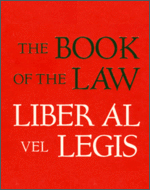

|
The Book of the Law
Saturday, May 31, 2008 | Music
Liber AL vel Legis is the central sacred text of Thelema, written (or received) by Aleister Crowley in Cairo, Egypt in the year 1904. Its full title is Liber AL vel Legis, sub figura CCXX, as delivered by XCIII=418 to DCLXVI, and it is common for adherents of Thelema to refer to it as The Book of the Law.
Liber AL vel Legis contains three chapters, each of which was written down in one hour, beginning at noon, on April 8, April 9, and April 10. Crowley claims that the author was an entity named Aiwass, whom he later referred to as his personal Holy Guardian Angel (or "Secret Self"). Biographer Lawrence Sutin quotes private diaries that fit this story, and writes that "if ever Crowley uttered the truth of his relation to the Book," his public account accurately describes what he remembered on this point. The teachings within this small book are expressed as the Law of Thelema, usually encapsulated by these two phrases:
- "Do what thou wilt shall be the whole of the Law" (AL I:40)
- "Love is the law, love under will" (AL I:57)
The original title of the book was Liber L vel Legis. Crowley retitled it Liber AL vel Legis in 1921, when he also gave the handwritten manuscript the title Liber XXXI. The book is often referred to simply as Liber AL, Liber Legis or just AL, though technically the latter two refer only to the manuscript.
Although the "messenger" of AL was Aiwass, the Book presents several personalities that are the primary speakers. The key three are the central godforms of the three chapters, Nuit, Hadit, and Ra-Hoor-Khuit.
The first chapter is spoken by Nuit, the Egyptian goddess of the night sky, called the Queen of Space. Crowley names her the "Lady of the Starry Heaven, who is also Matter in its deepest metaphysical sense, who is the infinite in whom all we live and move and have our being."
This chapter also introduces:
- Ankh-af-na-khonsu (the historical priest that created the Stele of Revealing)
- The Beast
- The Scarlet Woman, also known as Babalon, the Mother of Abominations
The second chapter is spoken by Hadit, who refers to himself as the "complement of Nu," his bride. As such, he is the infinitely condensed point, the center of her infinite circumference. Crowley says of him, "He is eternal energy, the Infinite Motion of Things, the central core of all being. The manifested Universe comes from the marriage of Nuit and Hadit; without this could no thing be. This eternal, this perpetual marriage-feast is then the nature of things themselves; and therefore everything that is, is a crystallization of divine ecstasy" and "He sees the expansion and the development of the soul through joy."
Ra-Hoor-Khuit is the third speaker, identified as the Crowned and Conquering Child, and the god of War and of Vengeance. Crowley sums up the speakers of the three chapters thus, "we have Nuit, Space, Hadit, the point of view; these experience congress, and so produce Heru-Ra-Ha, who combines the ideas of Ra-Hoor-Khuit and Hoor-paar-Kraat."
The Comment
Based on several passages, including: "My scribe Ankh-af-na-khonsu, the priest of the princes, shall not in one letter change this book; but lest there be folly, he shall comment thereupon by the wisdom of Ra-Hoor-Khuit" (AL I:36), Crowley felt compelled to interpret AL in writing. He wrote two large sets of commentary, where he attempted to decipher each line, usually according to his own understanding of the Qabalah.
However, he was not satisfied with these attempts. In 1912, he prepared AL and his current comments on it for publication in The Equinox, I(7). He recalls in his Confessions (p. 674) that he thought the existing commentary was "shamefully meagre and incomplete." He later explains, "I had stupidly supposed this Comment to be a scholarly exposition of the Book, an elucidation of its obscurities and a demonstration of its praeterhuman origin. I understand at last that this idea is nonsense. The Comment must be an interpretation of the Book intelligible to the simplest minds, and as practical as the Ten Commandments." Moreover, this Comment should be arrived at "inspirationally", as the Book itself had been.
Years later in 1925 while in Tunis, Crowley received his inspiration. He published[20] what was to become called simply The Comment (which is also called the Short Comment or Tunis Comment), and signed it as Ankh F N Khonsu (lit. "He Lives in Khonsu"—a historical priest who lived in Thebes in the 26th dynasty, the creator of the Stele of Revealing). It advises the reader against the "study" of the Book and states that those who "discuss the contents" should be shunned. The result is the common idea that interpretation of this often cryptic book is a responsibility for the reader alone. Some Thelemites ignore the Comment.

|


|

